How can I set backgrounds for each key on the android keyboard. KeyboardView android:keyBackground provides one background for all keys. But I want to set different backgrounds for every key.
4 Answers
I custom MyKeyBoradView extend the KeyBoardView and override the onDraw method.
public class MyKeyBoardView extends KeyboardView {
private Context mContext;
private Keyboard mKeyBoard;
public MyKeyBoardView(Context context, AttributeSet attrs) {
super(context, attrs);
this.mContext = context;
}
public MyKeyBoardView(Context context, AttributeSet attrs, int defStyle) {
super(context, attrs, defStyle);
this.mContext = context;
}
/**
* ov
*/
@Override
public void onDraw(Canvas canvas) {
super.onDraw(canvas);
mKeyBoard = this.getKeyboard();
List<Key> keys = null;
if (mKeyBoard != null) {
keys = mKeyBoard.getKeys();
}
if (keys != null) {
for (Key key : keys) {
// TODO: 16/8/23 different key set the different background
if (key.codes[0] == -4) {
drawKeyBackground(R.drawable.bg_keyboardview_yes, canvas, key);
drawText(canvas, key);
}
}
}
}
private void drawKeyBackground(int drawableId, Canvas canvas, Key key) {
Drawable npd = mContext.getResources().getDrawable(
drawableId);
int[] drawableState = key.getCurrentDrawableState();
if (key.codes[0] != 0) {
npd.setState(drawableState);
}
npd.setBounds(key.x, key.y, key.x + key.width, key.y
+ key.height);
npd.draw(canvas);
}
private void drawText(Canvas canvas, Key key) {
Rect bounds = new Rect();
Paint paint = new Paint();
paint.setTextAlign(Paint.Align.CENTER);
paint.setAntiAlias(true);
paint.setColor(Color.WHITE);
if (key.label != null) {
String label = key.label.toString();
Field field;
if (label.length() > 1 && key.codes.length < 2) {
int labelTextSize = 0;
try {
field = KeyboardView.class.getDeclaredField("mLabelTextSize");
field.setAccessible(true);
labelTextSize = spToPx((int) field.get(this));
} catch (NoSuchFieldException e) {
e.printStackTrace();
} catch (IllegalAccessException e) {
e.printStackTrace();
}
paint.setTextSize(labelTextSize);
paint.setTypeface(Typeface.DEFAULT_BOLD);
} else {
int keyTextSize = 0;
try {
field = KeyboardView.class.getDeclaredField("mLabelTextSize");
field.setAccessible(true);
keyTextSize = spToPx((int) field.get(this));
} catch (NoSuchFieldException e) {
e.printStackTrace();
} catch (IllegalAccessException e) {
e.printStackTrace();
}
paint.setTextSize(keyTextSize);
paint.setTypeface(Typeface.DEFAULT);
}
paint.getTextBounds(key.label.toString(), 0, key.label.toString()
.length(), bounds);
canvas.drawText(key.label.toString(), key.x + (key.width / 2),
(key.y + key.height / 2) + bounds.height() / 2, paint);
} else if (key.icon != null) {
key.icon.setBounds(key.x + (key.width - key.icon.getIntrinsicWidth()) / 2, key.y + (key.height - key.icon.getIntrinsicHeight()) / 2,
key.x + (key.width - key.icon.getIntrinsicWidth()) / 2 + key.icon.getIntrinsicWidth(), key.y + (key.height - key.icon.getIntrinsicHeight()) / 2 + key.icon.getIntrinsicHeight());
key.icon.draw(canvas);
}
}
public int spToPx(float sp) {
return (int) TypedValue.applyDimension(TypedValue.COMPLEX_UNIT_SP, sp, getContext().getResources().getDisplayMetrics());
}
}
The realization effect is as follows

This links:https://github.com/xuejinwei/NumberKeyboard
If you are writing your own IME, try using a drawable for the FOREground image (with android:keyIcon in XML or Key.icon in Java) that is equal to the size of the entire key. This is essentially equivalent to setting the background image of a single key. Of course you will also have to include the foreground in your image.
You will also have to use a background image with no padding, so it doesn't peek around the edges. See this posting for details on how to do this: how does a 9patch png work in android apps
Barry
- 1
- 1
- 12,316
- 13
- 72
- 135
I've been trying to do this too. The key background is drawn in onBufferDraw() in KeyboardView class. Problem is it is a private method, so you can't override it with a subclass. So I tried copying KeyboardView altogether and modifying that, but it uses com.android.internal.R resources, which an external app doesn't have access. So that approach doesn't work.
At this point it's starting to look like I have to throw Android's Keyboard classes out the window and write the whole thing from scratch --all b/c I can't get change the background image of the space key. Ridiculous.
- 29
- 2
-
Starting from scratch is not that difficult. In fact you can just copy/paste KeyboardView.java from the open source into a new subclass of KeyboardView, and start customizing it to suit your purposes. – Barry Fruitman Jan 27 '12 at 20:09
-
Many classes in Android are that impossible to customize. It would be much easier to accomplish if Android's architecture used delegates (or listeners) and permitted the replacement of helper classes at more points. – Huperniketes May 05 '13 at 01:49
-
I suggest copy/pasting KeyboardView.java into your own custom keyboard view class. That way you get all the functionality pre-written and you can override anything you need to. That's what I did. – Barry Fruitman Mar 29 '14 at 02:27